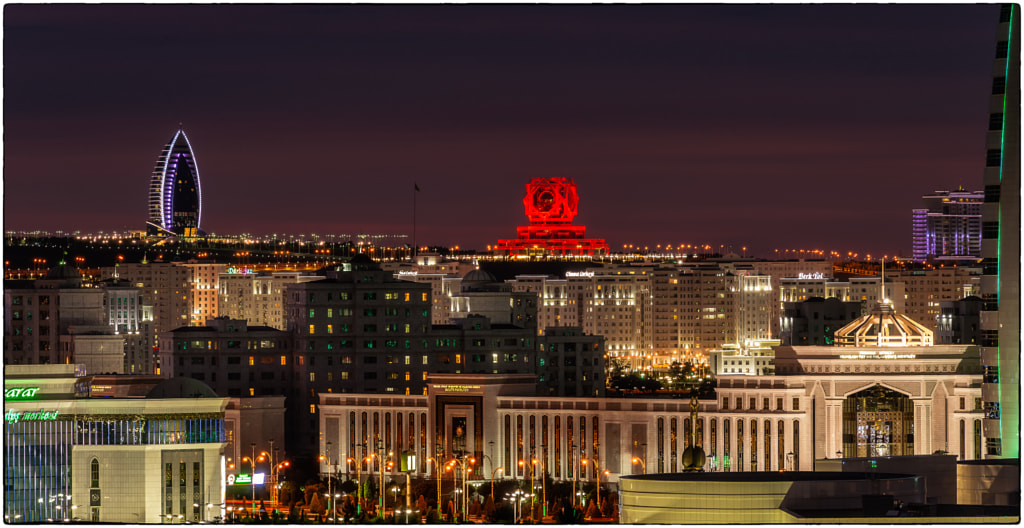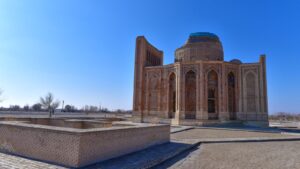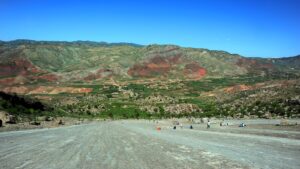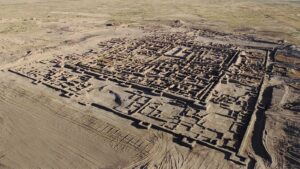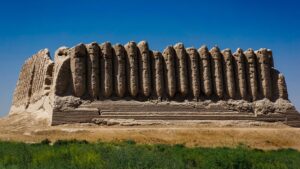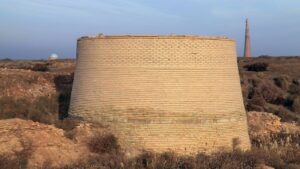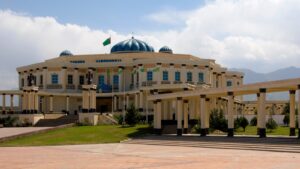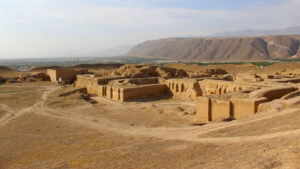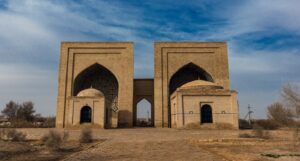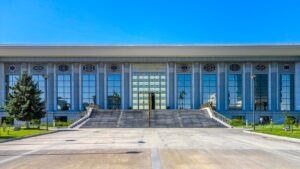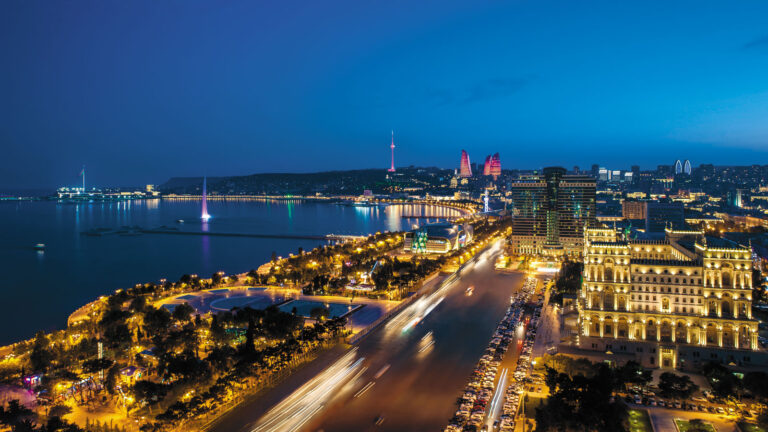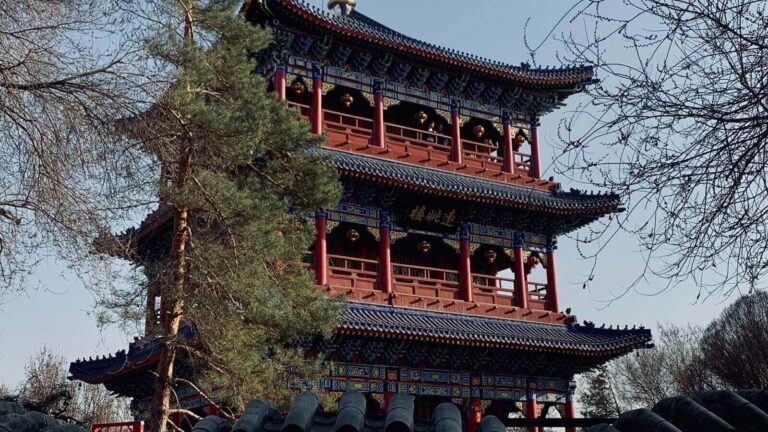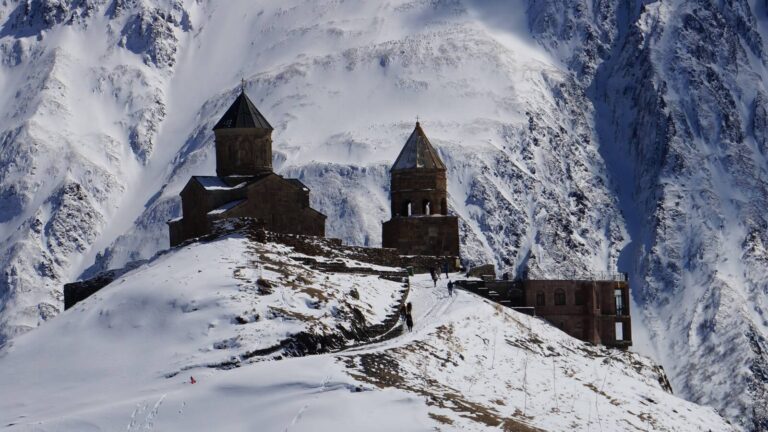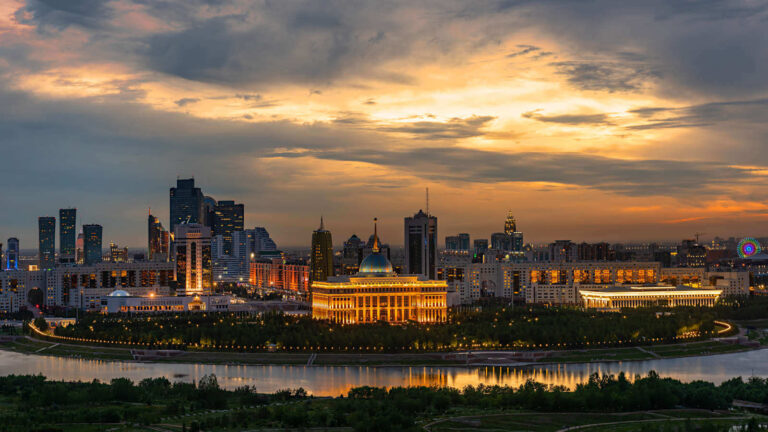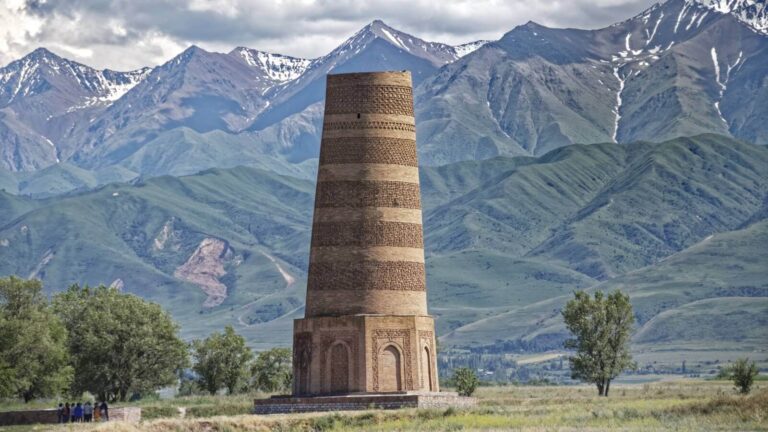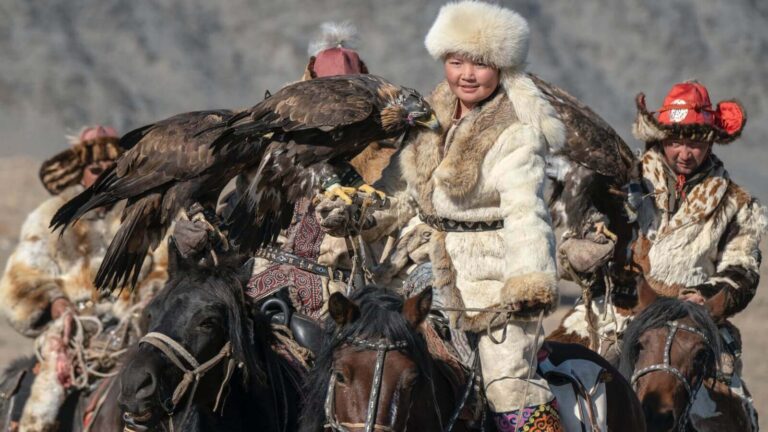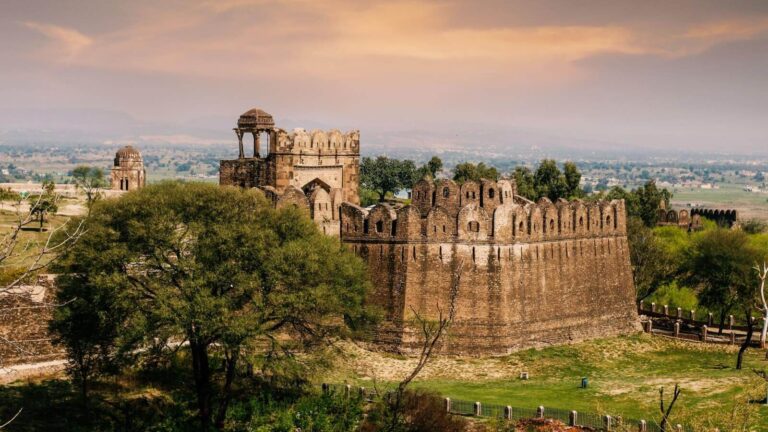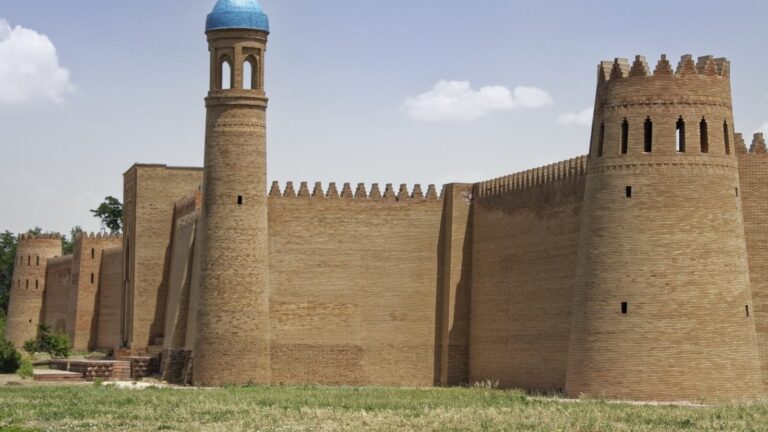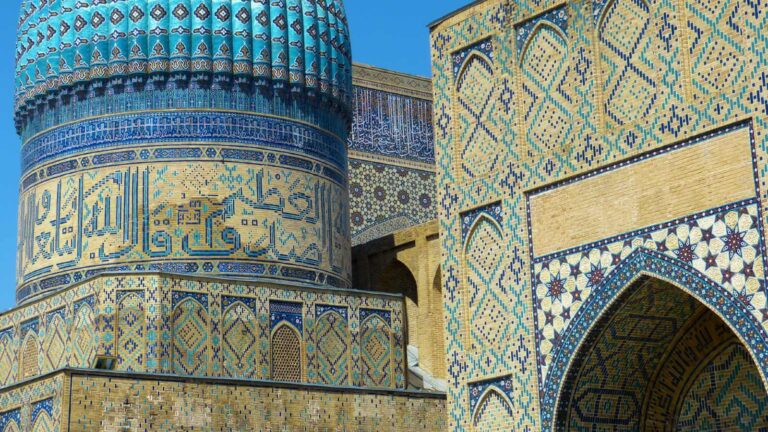Turkmenistan is one of the most diverse and fascinating countries in the region. Caravans of thee Silk Road passed through its regions of Margiana and Khorezm. Ancient monuments, mosques and fortresses, as like Nisa (III century BC), Kunya-Urgench (IX – XVI centuries), Ancient Merv, included in the UNESCO World Heritage List, won’t leave anyone indifferent.
Saragt is the birthplace of the great Sarakhsa, Myane is the birthplace of the great scientist Mehneyi, the mausoleum of Parav bibi, mausoleums – tombs of Soltan Sanjar, Il Arslan Khorezmshah, Shikh Attar, Astana baba are objects of Turkmen pilgrimage.
Having touched the Turkmen carpets with a unique pattern, riding the Akhal-Teke horse, seeing the natural beauty of the yellow Karakum sands, the traveler will leave warm memories for many years to come.
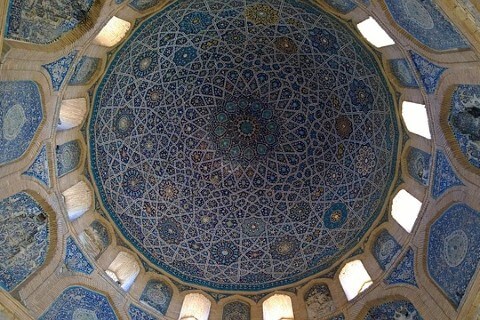
Language: Turkmen
Currency: Turkmen manat
Capital City: Ashgabat
Population: 7.1 million
History
The region was inhabited by numerous nomadic tribes before the rise of Islam. The Parthian Empire, in particular, left a lasting impact on the region, with its capital located in present-day Nisa.
Merv was one of the world’s largest cities in the 12th century, renowned for its grandeur and cultural sophistication. Another prominent city of historical significance is Konye Urgench, an ancient capital of the Khwarezmian Empire. Both cities flourished due to the Silk Road trade, but did not recover from the devastation of the Mongol conquest.
Throughout the medieval period, the area we now know as Turkmenistan was a crossroads of civilisations, influenced by Persian, Arab, Mongol, and Turkic cultures.
Turkmenistan became independent in 1991.
Today, Turkmenistan is one of the world’s fastest growing countries. Proclamation of Independence and the recognition as a permanently neutral State by the resolution of the UN General Assembly are the prerequisites for the country’s rapid growth as a major center for the international cooperation.
The capital Ashgabat is political, economic, intellectual and cultural center of the world-recognized state and considered to by trustworthy due to the constructive foreign policy of the distinguished President Serdar Berdimuhamedov.
Geography and Nature
Turkmenistan is dominated by the vast Karakum Desert. This desert is characterised by extensive sand dunes, rocky plateaus, and sparse vegetation.
In addition to the desert, Turkmenistan is also home to the Kopet Dag mountain range, which forms part of the country’s southern border with Iran.
The flora of Turkmenistan is adapted to the arid climate, and includes various types of desert vegetation such as shrubs, grasses, and drought-tolerant plants. In the mountainous regions, forests of oak, pistachio, and juniper trees can be found.
The country’s fauna is diverse and includes a range of species adapted to the desert environment. Wildlife in Turkmenistan includes the Turkmenian kulan (a type of wild ass), goitered gazelles, Bactrian camels, and various reptiles and rodents. The avian population is also rich, with numerous species of migratory birds passing through Turkmenistan during their annual migrations.
Economy
Turkmenistan’s economy is primarily based on natural resources, particularly its vast reserves of natural gas. The country ranks among the top natural gas producers in the world.
Turkmenistan has pursued a policy of state control over key industries, with the government playing a dominant role in the economy. The state-owned companies are involved in energy production, transportation, and infrastructure development.
Agriculture plays a vital role in the rural economy, with cotton production being a significant sector. Turkmenistan is known for its high-quality cotton, and it is one of the country’s major exports. Other agricultural products include wheat, fruits, and vegetables.
Creating modern transport and logistics infrastructure are among the priorities of the Turkmenistan’s economic policy. Turkmenistan actively entering new foreign markets, develops cooperation with partners in Europe, Asia, and America.
Today Turkmenistan has become one of the centers of transport communication along the East-West and North-South line. Turkmenistan is announcing important initiatives aimed at broad international cooperation development and meeting the fundamental interests of all countries and peoples, and also uses reasonable care of their practical implementation.
People and Culture
Turkmenistan’s official language is Turkmen, which is widely spoken, but Russian is also commonly used. Islam is the dominant religion.
Traditional arts and crafts hold a significant place in Turkmenistan’s culture, with carpet weaving being particularly renowned. Turkmen carpets, known for their intricate designs and vibrant colors, are considered masterpieces of craftsmanship.
The Akhal-Teke horse, known for its beauty and endurance, holds a special place in the hearts of the people. Equestrian sports are popular activities, reflecting the nomadic heritage of the Turkmen people.
Celebrations and festivals, such as Nowruz (the Persian New Year) and Independence Day, showcase the country’s cultural traditions and customs.
Hospitality is highly valued in Turkmenistan, and guests are warmly welcomed. Turkmen cuisine centres around the meat and dairy products of their traditional nomadic lifestyles.
Important Dates
Turkmenistan observes Islamic holidays such as Eid al-Fitr and Eid al-Adha, which vary each year based on the lunar calendar.
- January 1st: New Year’s Day – Celebrating the start of the Gregorian calendar year with fireworks and festivities.
- March 8th: International Women’s Day – Celebrating the achievements and contributions of women.
- March 21st: Nowruz – The Persian New Year, a holiday celebrated by many Turkmen people, marking the arrival of spring.
- 27 September: Independence Day – a celebration of the Declaration of Independence of Turkmenistan.
- October 6th: Memorial Day – Remembering the victims of the 1948 Ashgabat earthquake.
- December 12th: Day of Neutrality – A public holiday celebrating Turkmenistan’s neutrality.
The main port of entry is Ashgabat International Airport, with domestic flights available. Overland travel is possible by driving or taking buses. The country has a railway network connecting major cities. Taxis and local transport are available within cities.
By Plane
The primary gateway is Ashgabat International Airport, located in the capital city of Ashgabat. This airport serves as the hub for Turkmenistan Airlines, the national carrier, which operates flights to various domestic and international destinations.
Several major international airlines offer flights to Turkmenistan, connecting it with various countries. These include Turkish Airlines, Lufthansa, Flydubai, among others.
Connecting flights from major hubs such as Istanbul, Moscow, Dubai, Kazan, Frankfurt, Almaty, Minsk, Delhi, London, Beijing, provide convenient options for travellers from different parts of the world.
By Train
While you can use the train network within the country to travel between cities, Turkmenistan is not connected with its neighbouring countries via rail.
Comfortable trains stretch North-South and East-West routes. Ticket prices are affordable both for local citizens and foreign travelers, and can be purchased either on the website of the Turkmendemiryollary state enterprise or through a tour company.
Turkmenistan Railways Website: https://www.railway.gov.tm/
By Car
Travelling to Turkmenistan by car provides an opportunity for independent exploration and flexibility. The country shares land borders with Iran, Uzbekistan, Kazakhstan, and Afghanistan. The main border crossing points for car travel include Sarakhs (to Mashad), Farap (to Bukhara) and Shavat (to Khiva).
Turkmenistan-Uzbekistan border crossings:
- Dashoguz-Shavat 09:00 — 18:00
- Farap-Alat 24/7
Turkmenistan-Afghanistan border crossings:
- Imamnazar-Aqina 08:00 — 18:00
- Serhetabat-Torghundi 08:00 — 18:00
Turkmenistan-Iran border crossings:
- Saragt-Saraghs 08:30 — 16:30
- Artyk-Lotfabad 09:30 — 18:00
- Howdan-Bajgiran 09:00 — 17:00
Turkmenistan-Kazakhstan border crossings:
- Garabogaz 09:00 — 18:00
Turkmenbashi International Seaport (border with Russia and Azerbaijan)
By Bus
You can get to the country by bus through the following border crossings:
- Dashoguz (UZ)
- Farap (UZ)
- Imamnazar (AFG)
- Serhetabat (AFG)
- Saragt (Iran)
- Artyk (Iran)
- Howdan (Iran)
- Garabogaz (KZ)
By Sea
Travelers can cross the Caspian Sea by ferry from Baku, arriving to Turkmenbashi after a 12-15 hour journey. It is possible to take a car or motorbike on board.
To come to Turkmenistan by ship, you need to purchase a ferry ticket. Turkmenbashi International Sea Port provides high-quality passenger service between the Caspian seaports. This terminal houses a technical inspection center, disinfection department, the buildings of rail control and parking. With a total area of 230,000 square meters, the passenger terminal is capable of handling 300,000 passengers a year.
The Ferry Terminal building was designed to handle simultaneously 800 passengers, as well as receive four ferries at the same time. A hotel for 50 persons is located on the territory of the terminal.
Overall, Turkmenistan’s climate is characterised by long, hot summers and cold winters, with limited rainfall. Travellers should plan their visits accordingly, taking into account the seasonal variations in temperature and weather conditions.
In the summer months of June to August, temperatures can soar to extreme levels, especially in the desert areas, reaching over 40 degrees Celsius (104 degrees Fahrenheit).
During the winter months of December to February, temperatures can drop significantly, especially in the northern and mountainous regions, with average lows ranging from -5 degrees Celsius (23 degrees Fahrenheit) to -15 degrees Celsius (5 degrees Fahrenheit).
Spring (March to May) and autumn (September to November) are generally more moderate in terms of temperature, making them favourable seasons to explore the country.
Precipitation is scarce throughout the year, with the majority of rainfall occurring in the western and mountainous regions.
TURKMENISTAN WEATHERDiscover Turkmenistan’s best Destinations on each Season
Most travellers require visa to enter Turkmenistan. The visa application process typically involves obtaining an invitation letter from a local sponsor or tour operator. For detailed information on visa requirements and the application process, it is advisable to visit the official website of the Embassy of Turkmenistan or consult with a travel agency specializing in Turkmenistan travel.
Depending on the type of visa, a foreign citizen must go through registration process at the relevant government authorities (State Migration Service, Ministry of Foreign Affairs, the tourism department of the Ministry of Culture of Turkmenistan)
For more information, please visit www.migration.gov.tm
On the basis of issued invitations, visas can be obtained at diplomatic missions and consulates of Turkmenistan abroad or at the border crossings. Additional information available at www.migration.gov.tm
Turkmenistan does not typically require specific vaccinations for entry. However, it is advisable to check the latest health recommendations and requirements from your local health department or a trusted travel health website before traveling to Turkmenistan.
Foreign visitors must have a valid international driver’s license or a driver’s license issued by their home country to drive in Turkmenistan. It is advisable to carry both your original driver’s license and the international driver’s license while driving.
Driving: Renting a car is not possible in Turkmenistan, but you can drive your own vehicle. It is important to have the necessary documentation, including a valid driver’s license and vehicle registration papers. However, driving in Turkmenistan can be challenging due to the state of some roads.
Bus: Public buses operate within cities and between major towns in Turkmenistan. They are an affordable and commonly used mode of transport for both locals and tourists. Buses may vary in terms of comfort and frequency, and it is advisable to check schedules and routes in advance. Private minivans, known as “marshrutkas,” also provide transportation services on popular routes.
Taxis and Ride Sharing: Taxis are readily available in cities and towns, and they can be hailed on the street or arranged through hotels or taxi stands. Negotiating the fare before the journey is common practice. There are no ride-sharing services.
Train: The railway network in Turkmenistan connects major cities and towns. Trains are a comfortable and efficient mode of long-distance travel, offering different classes of accommodation. Tickets can be bought at stations or online through the website.
Air Travel: Turkmenistan has several domestic airports, allowing for quick and convenient travel between different regions of the country. Turkmenistan Airlines operates domestic flights connecting major cities like Ashgabat, Mary, Turkmenbashi, Dashoguz, Turkmenabat, Valkanabat, Kerki.
Boat Travel: Turkmenbashi has ferry services connecting to Baku.
Turkmenistan operates on a 220-240V electrical system with a standard frequency of 50Hz. Power outlets generally accommodate two-round-pin plugs.
While there have been improvements in communication infrastructure and technology in Turkmenistan, it is important to note that internet access and content remain highly restricted and that online activity is strictly monitored.
In Turkmenistan the WI-FI services are available in Ashgabat and in all regions.
Turkmenistan’s hotel inventory remains offline and cannot be booked through traditional booking platforms. Instead, use a local tour operator to book your accommodation.
The country has a variety of options, from homestays to 5-star luxury hotels.
Turkmen cuisine offers a delicious blend of flavours influenced by Central Asian, Persian, Russian and Middle Eastern culinary traditions. Some popular dishes include:
Plov: A traditional rice dish cooked with meat, vegetables, and fragrant spices like saffron and cumin.
Shashlik: Grilled skewered meat (usually lamb or beef) marinated in a variety of spices and served with bread and vegetables.
Manti: Dumplings filled with seasoned meat and served with yogurt or sour cream.
Samsa: Flaky pastries stuffed with meat or vegetables, similar to Indian samosas.
Lagman: Noodle soup with chunks of meat, vegetables, and aromatic spices.
When dining in restaurants in Turkmenistan, it is advisable to choose establishments with good hygiene practices. It is recommended to avoid tap water. Tipping in restaurants is not common practice in Turkmenistan. However, leaving a small amount as a gesture of appreciation for good service is becoming more common in upscale restaurants.
For a unique dining experience, consider trying traditional tea houses (chaykhana) where you can enjoy a cup of aromatic Turkmen tea and indulge in local snacks like plov, samsa, or sweets.
The official currency of Turkmenistan is the Turkmenistan Manat (TMT). Get live exchange rates here. It is advisable to carry sufficient dollars when entering the country, as credit cards are not widely accepted and you may struggle using ATMs. Foreign currency exchange can be done at authorised banks and exchange offices.
When it comes to shopping, traditional Turkmen carpets, known for their intricate designs and vibrant colors, are a bestseller. Other traditional crafts such as jewelry, handwoven textiles, and embroidered goods are also widely available.
Business hours in Turkmenistan vary, but most government offices, banks, and businesses operate from Monday to Friday between 9am and 6pm, with a break for lunch in the afternoon. Some businesses may close on Saturdays, while Sundays are typically considered a day off.
It’s worth noting that Turkmenistan has strict regulations regarding the export of certain goods, including antiques, carpets, and cultural artifacts. It is important to familiarise yourself with the customs regulations to avoid any complications when leaving the country. Remember to carry sufficient cash and explore the local bazaars for an authentic shopping experience.
Respect for Elders: Turkmen culture places great importance on respect for elders. It is customary to greet and show deference to older people, and it is considered impolite to sit before them or start eating before they do.
Dress Code: When visiting religious sites or attending formal events, it is appropriate to dress modestly. Women are expected to cover their heads and wear long skirts or trousers, while men should wear long trousers and avoid wearing shorts.
Tipping: Tipping is not a common practice in Turkmenistan. However, in upscale hotels and restaurants, a service charge may be included in the bill. If you receive exceptional service, a small tip can be given as a token of appreciation.
Major Religions: Islam is the predominant religion in Turkmenistan, with the majority of the population being Sunni Muslims. Visitors should be respectful of Islamic customs and practices.
Alcohol and Smoking: Turkmenistan has strict regulations regarding smoking. Cigarettes are not widely available. Smoking is also restricted in many public places, including restaurants and government buildings.
Photography and Videography: When taking photos or videos, it is advisable to ask for permission, especially in religious sites, at government buildings or when photographing individuals.
Celebrations
In the era of the Renaissance of the new era of a powerful state, there will be no end to the bright holidays on the Turkmen land, as like Turkmen toi – any feast with ritual ceremonies, music accompaniment and various sports. Turkmens hold toi on the occasion of newlyweds’ weddings, baby’s first haircut (galpak toýy), baby’s first step (ädim toýy), first tooth (diş toýy), etc. The Ak goyun feast is dedicated to the age of the Prophet. Everyone who reaches the age of the Prophet, 62 years, should celebrate their birthday by holding a feast.
Carpet Weaving
Carpet weaving is one of the ancient traditions of the people. For a nomadic Turkmen, the carpet has always been a necessary furniture item. Easily transportable and warm, carpets were used for a variety of purposes, including covering the outer contours of yurts (“ak oy”), flooring, and as a bed. Being very complex and time consuming, the art of carpet making passed down from generation to generation, and the ability of beautiful carpets weaving was considered to be one of the main advantages of brides and wives. Carpets are symbol of Turkmen culture in general, and its ornaments (göli) are depicted the Turkmenistan flag.
Horse Breeding
The Turkmen have centuries-old horse breeding traditions. Akhal Teke horses have been bred for more than 3,000 years, making them one of the oldest horse breeds known. Akhal-Teke horses are the greatest achievement of the Turkmen people. They are not only fast and of great endurance but also of peculiar royal beauty. These horses became one of the most striking illustrations of talent and mastery of Turkmen people. Turkmen are very proud of their horses.
It is advisable to stay updated on travel advisories and follow the guidance of local authorities. Be aware of your surroundings, particularly in crowded places and tourist areas. Avoid displaying valuable items and keep your belongings secure.
Medical Treatment and Insurance: Before traveling to Turkmenistan, ensure that you have comprehensive travel insurance that covers medical expenses and emergency medical evacuation. Familiarise yourself with the location of nearby medical facilities and carry a basic first aid kit.
Health and Vaccinations: It is advisable to consult with a healthcare professional or travel clinic before your trip to Turkmenistan to receive updated information on necessary vaccinations and health precautions. Ensure that your routine vaccinations are up to date.
Natural Disasters: Turkmenistan is susceptible to earthquakes and extreme weather conditions. Stay informed about weather forecasts and follow the guidance of local authorities in case of natural disasters. It is also recommended to register with your embassy or consulate upon arrival for emergency notifications.
Emergency Services: In case of emergencies, Turkmenistan has emergency services such as police, fire, and ambulance services. Dial the emergency number 112 for immediate assistance.
In case of Emergency
Police: 102
Ambulance: +993 90 69 03
Other Useful Contacts
- Tourist Information Centres:
- The Ministry of Culture of Turkmenistan: +993 12 35 33 81
- Ashgabat Tourist Information Centre: +993 12 35 65 68
- Hospitals and Medical Services:
- Ashgabat City Hospital: +993 12 22 25 00
- Turkmenabat Central City Hospital: +993 558 9 14 99
- Police:
- Emergency Police Assistance (Ashgabat): 102
- Non-Emergency Police (General Directorate of Police): +993 12 39 30 04

